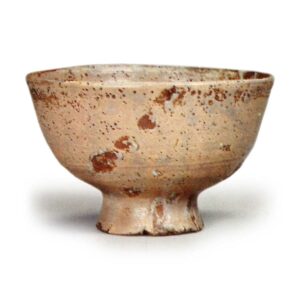
One of a group of Korean Wu ware tea bowls. The glaze is beautifully decorated with red deer spots.
It is named so because it has red deer-steppe spots on the glaze. It is smaller than Daitokuji Wu ware, and is similar to the Han-uso type, but of a different quality.
The base is made in a different style and is deep, with natural spatula marks. The glaze is not wet, but has a persimmon fire- or blue-reddish color, and in general this is a fine piece. This type of tea bowl was originally owned by Daitokuji Temple, then by Toyotomi Hideyoshi, and finally by Tokugawa Ieyasu, and remained in the Tokugawa family until the Meiji Restoration, but was destroyed by fire in Ueno during the Boshin War. The most famous existing tea bowl of this type is the Daimonomono Momiji Gokki, which came from the Hirooka family in Osaka, and fetched 189,900 yen, the highest price ever recorded for a tea bowl, at a bidding held by the same family in June 1928.



